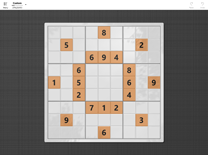Number-in' Places
Number-in' Places is an integrated design tool for number placing puzzles (a.k.a. sudoku puzzles) tailored for publishers, experts and every puzzle fan. The app brings you the stable design system based on high-end puzzle-solving logic and GPU-accelerated responsive graphical user interface, which allow you to create, analyze and/or test-play well-composed deductively solvable puzzles easily on your device.


*Number-in' Places is available for Universal Windows® Platform. PC, tablet or another kind of device running Microsoft® Windows® 10 is required to use the application.
*Microsoft and Windows are either registered trademarks or trademarks of Microsoft Corporation in the United States and/or other countries.
Features
- Design: Design your original puzzle by computer-assisted manual composition or by automated pattern-based creation*.
- Analysis: Powerful computational analyzer brings you information required to evaluate puzzles (consistency, deductive/inductive solvability, difficulty, etc.).
- Test-play: The handy graphical test-play user interface supporting prompt input checks, timer, undo/redo and hints helps you try solving puzzles to measure actual difficulties by your hand.
- Daily puzzles: Play pre-built daily sample puzzles in various difficulty levels (easy, medium, hard or expert) delivered to make your skill in solving puzzles even further better.
- Preference: The workspace can be customized by choosing colors in dozens of predefined color-sets and/or by adjusting sizes of UI-components.
- I/O: Import/export puzzle input data or pattern data from/to CSV files for working with digital media, or print out puzzles for off-line uses.
*Pattern-based puzzle creation fulfills conversion of 9×9 dot patterns into deductively solvable puzzles. This is an optional feature. Payment is required to use this function. There are some theoretical and/or computational restrictions on pattern designs. See documentation for details.
Basics of number placing puzzle
Definitions of terms
- Board: The puzzle grid consists of 9×9 squares.
- Row: Horizontal 9×1 line on the Board.
- Column: Vertical 1×9 line on the Board.
- Block: Boxed 3×3 sub-grid on the Board.
- Sub-unit: Row, Column or Block.
The rules of number placing puzzle
The objective of the number placing puzzle is to fill all the empty squares on the Board with digits (1 to 9), avoiding conflictions between digits. The rules can be summarized in a brief form: Each Sub-unit must be filled with digits in a set {1 to 9}, where each digit may appear only once in the Sub-unit.
Designing number placing puzzle
Generally, a puzzle can be designed by setting some starting clue-digits on the Board so that the puzzle can satisfy following conditions*.
- Valid: Starting clues may not break the rules.
- Solvable: Solver can complete the puzzle by putting all the digits without breaking the rules.
- Determinable: The puzzle need to have the only one solution.
*The app automates all the complicated processes required to make puzzles satisfy those conditions.
Deductively solvable or otherwise
In some cases, the kinds of puzzle solving methods (that human solvers need to use to complete puzzles; either deductive methods or inductive methods) may matter. e.g. In publications for general public, a puzzle that cannot be solved only by deductive methods won't be regarded as a valid (solvable) puzzle.
- Deductively solvable: At least one or more determinable digits/squares always exist on the Board through-out a play. Solver can step-forwardly determine all the digits only with deductive inferences based on the rules.
- Inductively solvable*: At some point during a play, solver confronts stalling situation where there exists no determinable digit/square subject to the rules. The solver need to use assumption to proceed. In case the digit assumed is found to be incorrect later, the solver has to take a backtrack.
*More precisely, "Solvable by using inductive methods partly". Even in such a puzzle, a large portion of the board can be filled by deductive methods. The app doesn't yield puzzles that solvers need resort to inductive methods to finish.